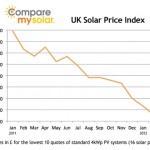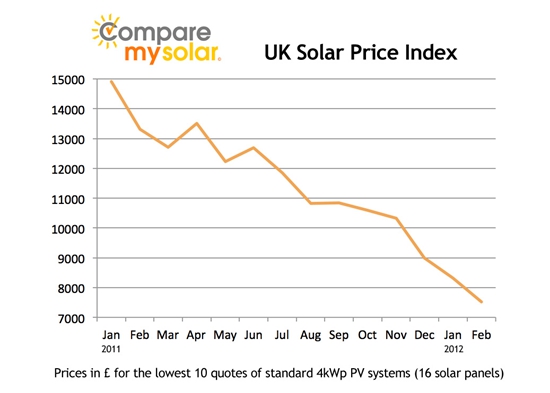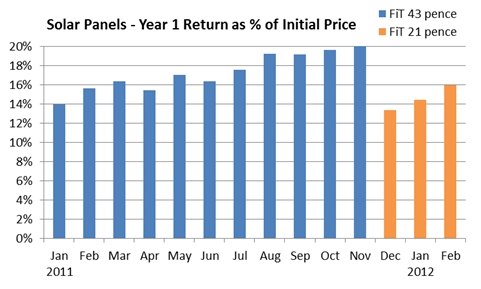 This is a copy of a guest blog by CompareMySolar for the SolarPowerPortal, which has been ‘most read’ for over a week now. The price of residential solar panel installations has dropped by 50 percent since early 2011, according to research by CompareMySolar. Therefore, consumers can achieve a similar financial return as before – despite cuts in the feed-in-tariff from 43p to 21p. Building more awareness around this can help drive demand, following recent negative news about subsidy cuts and court cases.
This is a copy of a guest blog by CompareMySolar for the SolarPowerPortal, which has been ‘most read’ for over a week now. The price of residential solar panel installations has dropped by 50 percent since early 2011, according to research by CompareMySolar. Therefore, consumers can achieve a similar financial return as before – despite cuts in the feed-in-tariff from 43p to 21p. Building more awareness around this can help drive demand, following recent negative news about subsidy cuts and court cases.
Solar prices drop 50 percent
Since January 2011, CompareMySolar’s “UK Solar Price Index” has amassed over 1,500 quotes for home installations and shows that a 4kWp system that used to cost £15,000 can now be bought for around £7,500 (see first graph). Price drops have accelerated in the last three months (from £10,500 towards £7,500) following feed-in tariff cuts, and are mostly driven by much lower module prices and increased competition.
Returns improve to 2011 level
Due to these strong price drops, the financial return for consumers is currently at similar levels as it used to be in the first half of 2011. The second graph illustrates this for an example roof in Exeter (south facing, optimal angle, no shading), where a 4kWp solar panel system is expected to generate around 4,000 kWh in the first year. If we assume the property consumes half the electricity generated in house and exports the other half to the grid, the expected year one payback is:
- (43p FiT) 4,000 x 0.43 = £1,720 from Government feed-in tariff
- (21p FiT) 4,000 x 0.21 = £840 from Government feed-in tariff
- 2,000 x 0.15 = £300 from electricity savings
- 2,000 x 0.03 = £60 from the export tariff.
The total year one payback used to be £2,080 on the 43p feed-in tariff, and is currently around £1,200 at the 21p rate. While this looks like a very large drop in financial return, please keep in mind prices halved as well. Combining these payback amounts with prices paid for the installation (based on the monthly price index) provides the more relevant perspective. The below graph shows that where year one payback used to be around 14-16 percent of the initial price in the first half of 2011, it currently is back at 16 percent. Therefore, solar panels are currently just as attractive as around June 2011.
Not only price that matters
Certainly price is not the only, or the most important, factor in buying solar panels. Since solar panels will generate income over 25 years, it is important to take the long view for peace of mind about the investment. Choosing a large manufacturer that is either in the top ten of global solar panel firms or part of an electronics conglomerate is a safe choice, since it helps to ensure future warranty of guaranteed panel outputs. Picking a long-lasting and efficient inverter helps to minimise maintenance costs going forward. And, choosing an experienced and reputable installer with longer (insurance backed) warranty on workmanship gives further peace of mind. But getting a competitive price in line with the market is the basis of good future returns.
Drive awareness to drive demand
Given all the recent press about feed-in tariff cuts and court cases, many consumers have negative ideas about going solar now. This clearly shows in diminished demand, which is falling off the cliff again after the March 3 deadline, according to the Department of Energy and Climate Change. Weekly installations have dropped by 95 percent, from more than 20,000 towards 1,100 in the week after the deadline; demand currently sits at less than half the level of June last year – despite similar returns. Raising consumer awareness about the financial return of solar panels on 21 pence will help to build trust and drive demand. This will be much needed for solar installers looking to maintain and build their business during a difficult 2012.

